Blog to watch: Madame Royale, a blog
Blog to watch: Madame Royale, a blog about notable women from the past. (via cyn-c)



This site is made possible by member support. 💞
Big thanks to Arcustech for hosting the site and offering amazing tech support.
When you buy through links on kottke.org, I may earn an affiliate commission. Thanks for supporting the site!
kottke.org. home of fine hypertext products since 1998.
Blog to watch: Madame Royale, a blog about notable women from the past. (via cyn-c)
David Plotz has finished his Blogging the Bible series at Slate…he wrote about each book of the Old Testament. “While I’ve been blogging the Bible, I have tried not to take myself too seriously and not to pretend more insight than I actually have. I just wanted to read the book and write about what it’s like to read it. No essays, no philosophy, no experts.”
Meant to post about this last week, but going on right now in NYC: Postopolis. “Postopolis! is a five-day event of near-continuous conversation about architecture, urbanism, landscape, and design. Four bloggers, from four different cities, will host a series of live discussions, interviews, slideshows, panels, talks, and other presentations, and fuse the informal energy and interdisciplinary approach of the architectural blogosphere with the immediacy of face to face interaction.” More about the event from City of Sound and BLDGBLOG.
The BLDGBLOG book will likely be as interesting as the BLDGBLOG blog. Topics will include “plate tectonics and J.G. Ballard to geomagnetic harddrives and undiscovered New York bedrooms, by way of offshore oil derricks, airborne utopias, wind power, inflatable cathedrals, statue disease, science fiction and the city, pedestrianization schemes, architecture and the near-death experience, Scottish archaeology, green roofs…”
This recent interview of journalist Jonathan Rauch is full of good stuff. On bad predictions and making mistakes:
Everybody makes [mistakes]; it’s par for the course. What I have learned is not to be too sure I’m right. The world is much more surprising than we give it credit for. That’s part of my political philosophy, my philosophy of life. That’s really fundamental to it: Trial and error is really the only thing in life that works ultimately over the long term. Journalism is like that, too, so we need to be honest about our mistakes. We often aren’t enough. Everybody makes mistakes. And we need to be a little bit cautious about making predictions.
On real journalism vs. opinion:
There’s a very talented, hard-working press corps and, of course, it represents only a small fraction of the people who are doing [journalism]. I think all the major newspapers are doing it well. Not a single one is doing it badly, the ones that are committing resources to it. The larger fraction are the parasites, the bloggers, commentators, opinionizers — I don’t exempt myself — who are feeding off of the real news that the press is providing. That larger sort of commentariat is not doing a very good job.
The future of real journalism:
What I worry about is what everyone in my business worries about: Who’s going to fund the real reporting? The magazine and newspaper business was a cross-subsidy. You had the advertising, particularly classified, and you had a local market, which subsidized the gathering of news. That model is breaking down because the bundle is breaking into pieces and it’s hard to see in the long run who funds the kind of large-scale news reporting operations that the major papers have run if the advertising is all going online and if people can all get the news for free at Yahoo.
On extremism in American politics:
The [political] system has been rigged by partisan activists to their advantage. They participate in primaries. General elections don’t matter because they’ve gerrymandered the congressional districts. They have the advantages of energy and being single-minded and they use these wedge issues which they’re very good at and which both sides conspire in using in order to marginalize the middle. The result of that is the turnout among moderates and independents is down; turnout on the extremes is up. The parties are increasingly sorted by ideology so that all the liberals are in one party and all the conservatives are in another. That is a new development in American history.
On getting out of the way of a story:
I’m not a fan of the idea that the journalist and the journalist’s attitude should be front and center. I think that a good journalist’s duty is to get out of the way. The hardest thing about journalism — the hardest thing, a much higher art than being clever — is just to get out of the way, to show the leader of the world as the reader would see it if the reader were there. Just to be eyes and ears. Calvin Trillin, another writer I greatly admired who steered me towards journalism, once said that getting himself out of his stories was like taking off a very tight shirt in a very small phone booth. He’s right.
And lots more…I recommend reading the entire thing, especially the exchange between Rauch and the interviewer about personal political identities that was too long/difficult to excerpt here. Much more from Rauch here.
Heather Armstrong, on meeting her new neighbors and having to explain what she does for a living:
Over the last few weeks several neighbors have stopped by to introduce themselves, and invariably they are older than we are, more established, and have careers in medicine or law. And when they ask what we do, both Jon and I sort of flinch and exchange a quick look that says IT’S YOUR TURN TO LIE. We’re web developers, we say, and that is never enough, they just can’t leave it alone, and one of us will try to explain that I have a website. This thing. That I do. And because we’re being all coy about it I just know, from the very worried expressions on their faces, that these neighbors think that we run a porn site.
This is the exact interaction I have with most people that I’ve met in the past couple of years, right down to the “we’re web developers, we say, and that is never enough, they just can’t leave it alone” part. I imagine professional mimes, phone sex operators, and people who make a living selling other people’s stuff on eBay have the same sorts of awkward conversations with their new neighbors.
Remember the guys humping the ottoman video from Friday? There’s a sequel of sorts: how to blog. (via dens)
Clive Thompson on the new way to make it big in the music biz: spend hours a day communicating with your fans via the web. “Virtually everyone bemoaned the relentless and often boring slog of keyboarding. It is, of course, precisely the sort of administrative toil that people join rock bands to avoid.”
Update: Related: How to Be a Star in a YouTube World.
Street artist Banksy gets the New Yorker treatment with a profile in this week’s issue. “The graffitist’s impulse is akin to a blogger’s: write some stuff, quickly, which people may or may not read. Both mediums demand wit and nimbleness. They arouse many of the same fears about the lowering of the public discourse and the taking of undeserved liberties.” Complex tracked down the alleged photos of Banksy mentioned in the article. Print magazine recently wrote a piece on Banksy as well.
Regarding the Twitter vs. Blogger thing from earlier in the week, I took another stab at the faulty Twitter data. Using some educated guesses and fitting some curves, I’m 80-90% sure that this is what the Twitter message growth looks like:
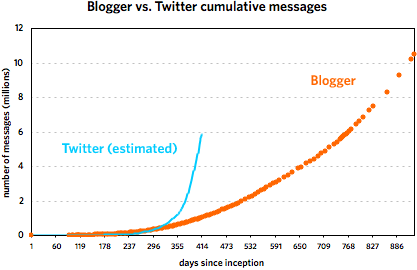
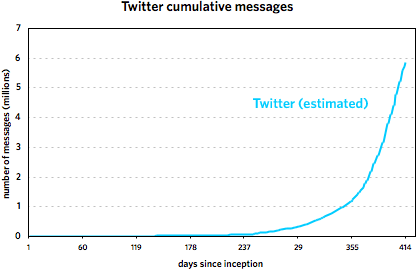
These graphs cover the following time periods: 8/23/1999 - 3/7/2002 for Blogger and 3/21/2006 - 5/7/2007 for Twitter. It’s important to note that the Twitter trend is not comprised of actual data points but is rather a best-guess line, an estimate based on the data. Take it as fact at your own risk. (More specifically, I’m more sure of the general shape of the curve than with the steepness. My gut tells me that the curve is probably a little flatter than depicted rather than steeper.)
That said, most of what I wrote in the original post still holds, as do the comments in subsequent thread. Twitter did not grow as fast as the faulty data indicated, but it did get to ~6,000,000 messages in about half the time of Blogger. Here are the reasons I offered for the difference in growth:
1. Twitter is easier to use than Blogger was and had a lower barrier to entry.
2. Twitter has more ways to update (web, phone, IM, Twitterific) than did Blogger.
3. Blogger’s growth was limited by a lack of funding.
4. Twitter had a larger pool of potential users to draw on.
5. Twitter has a built-in social aspect that Blogger did not.
And commenters in the thread noted that:
6. Twitter’s 140-character limit encourages more messages.
7. More people are using Twitter for conversations than was the case with Blogger.
What’s interesting is that these seeming advantages (in terms of message growth potential) for Twitter didn’t result in higher message growth than Blogger over the first 9-10 months. But then the social and network effects (#5 and #7 above) kicked in and Twitter took off.
Since swearing off Technorati a couple of years ago, I’ve been checking back every few months to see if the situation has improved. The site is definitely more responsive but their data problems seemingly remain, at least with regard to kottke.org; Google Blog Search gives consistently better results and easy access to RSS feeds of searches.
Technorati recently introduced something called the Technorati Authority number, which is a fancy name for the number of blogs linking to a site in the last six months. Curious as to where kottke.org fell on the authority scale, I checked out the top 100 blogs list. Not there, so I proceeded to the “Everything in the known universe about kottke.org” page where a portion of that huge cache of kottke.org knowledge was the authority number: 5,094. Looking at the top 100 list, that should put the site at #47, nestled between The Superficial and fishki.net, but it’s not there. Technorati also currently states that kottke.org hasn’t been updated in the last day, despite several updates since then and my copy of MT pinging Technorati after each update.
Maybe kottke.org has been intentionally excluded because I’ve been so hard on them in the past. Or maybe it’s just a glitch (or two) in their system. Or maybe it’s an indication of larger problems with their service. Either way, as the company is attempting to offer an authentic picture of the blogosphere, this doesn’t seem like the type of rigor and accuracy that should send reputable media sources like the BBC, Washington Post, NY Times, and the Wall Street Journal scurrying to their door looking for reliable data about blogs.
Update: As of 3:45pm EST, the top 100 list has been updated to include kottke.org. The site also picked up this post right away, but failed to note a subsequent post published a few minutes later..
Directory of the earliest Blogger users from 1999. A surprising number of those blogs are still regularly published, although few of them still use Blogger.
This morning I posted a comparison of the growth in messages with both Blogger and Twitter. The Twitter data was based on information collected by Andy Baio in a post that was widely read in the blogosphere. In the course of looking at the Twitter data, neither of us noticed that from Nov 21, 2006 to Feb 4, 2007 and March 9, 2007 to the present, the Twitter post IDs had the same last digit, indicating that the data is not strictly sequential. If you look at Twitter’s public timeline, the Twitter post IDs skip around by multiples of 10.
Anil suggested via email that could be an artifact of database sharding and lo and behold, if you take off the last digit of the post ID, they seem to become sequential again, more or less. He’s going to ask the Twitter gang about it.
For right now though, the parts of this morning’s post that rely on Twitter data from the above dates is incorrect. Basically, all of it. Here it is in all caps: WRONG WRONG WRONG ERROR ERROR, F——-, WOULD NOT BUY DATA ANALYSIS FROM AGAIN. In hindsight, it seems obvious that the data was incorrect…that sort of growth seems impossible, especially when Twitter was having all sorts of scaling problems. Anyway, good thing this is just a blog and not a refereed journal, eh? Big thanks to the commenters in the other post for pointing me toward the error. More as I have it.
Update: Email from Biz Stone, who works for Twitter. He says:
There’s truth in the essence of what you’re talking about here — Twitter updates *are* coming in faster and furiouser than Blogger updates. However, the way we number Twitter updates has switched back and forth a few times which pretty much screws up the exactness of your analysis.
We have been doubling the number of active users about every three weeks for a sustained period of months now which is definitely contributing significantly to more and more updates. Also, active users of Twitter a measured by how many times they update per day (at Blogger it was per month). So activity in general at Twitter is crazy by comparison.
We’re going to start digging in to more data visualization, user patterns, etc in the coming weeks so if there’s anything you think we should be looking at specifically please let us know!
So we’ll have to wait a few weeks for an accurate look at this stuff. (thx, biz)
Important update: I’ve re-evaluated the Twitter data and came up with what I think is a much more accurate representation of what’s going on.
Important update: I’ve re-evaluated the Twitter data and came up with what I think is a much more accurate representation of what’s going on.
Further update: The Twitter data is bad, bad, bad, rendering Andy’s post and most of this here post useless. Both jumps in Twitter activity in Nov 2006 and March 2007 are artificial in nature. See here for an update.
Update: A commenter noted that sometime in mid-March, Twitter stopped using sequential IDs. So that big upswing that the below graphs currently show is partially artificial. I’m attempting to correct now. This is the danger of doing this type of analysis with “data” instead of data.
—
In mid-March, Andy Baio noted that Twitter uses publicly available sequential message IDs and employed Twitter co-founder Evan Williams’ messages to graph the growth of the service over the first year of its existence. Williams co-founded Blogger back in 1999, a service that, as it happens, also exposed its sequential post IDs to the public. Itching to compare the growth of the two services from their inception, I emailed Matt Webb about a script he’d written a few years ago that tracked the daily growth of Blogger. His stats didn’t go back far enough so I borrowed Andy’s idea and used Williams’ own blog to get his Blogger post IDs and corresponding dates. Here are the resulting graphs of that data.1
The first one covers the first 253 days of each service. The second graph shows the Twitter data through May 7, 2007 and the Blogger data through March 7, 2002. [Some notes about the data are contained in this footnote.]
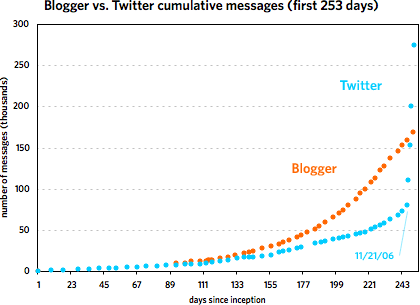
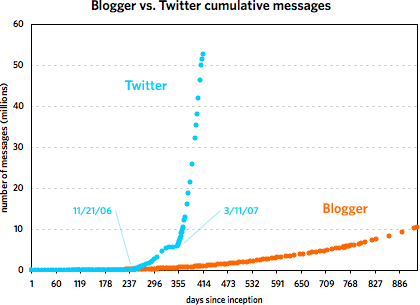
As you can see, the two services grew at a similar pace until around 240 days in, with Blogger posts increasing faster than Twitter messages. Then around November 21, 2006, Twitter took off and never looked back. At last count, Twitter has amassed five times the number of messages than Blogger did in just under half the time period. But Blogger was not the slouch that the graph makes it out to be. Plotting the service by itself reveals a healthy growth curve:
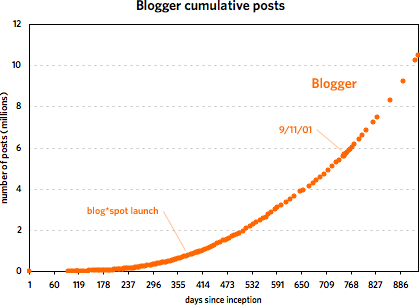
From late 2001 to early 2002, Blogger doubled the number of messages in its database from 5M to 10M in under 200 days. Of course, it took Twitter just over 40 days to do the same and under 20 days to double again to 20M. The curious thing about Blogger’s message growth is that large events like 9/11, SXSW 2000 & 2001, new versions of Blogger, and the launch of blog*spot didn’t affect the growth at all. I expected to see a huge message spike on 9/11/01 but there was barely a blip.
The second graph also shows that Twitter’s post-SXSW 2007 growth is real and not just a temporary bump…a bunch of people came to check it out, stayed on, and everyone messaged like crazy. However, it does look like growth is slowing just a bit if you look at the data on a logarithmic scale:
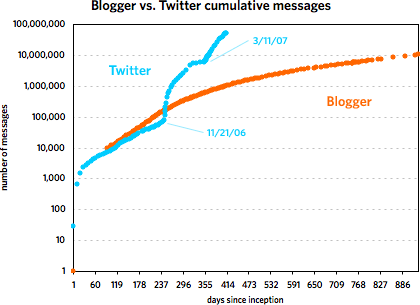
Actually, as the graph shows, the biggest rate of growth for Twitter didn’t occur following SXSW 2007 but after November 21.
As for why Twitter took off so much faster than Blogger, I came up with five possible reasons (there are likely more):
1. Twitter is easier to use than Blogger was. All you need is a web browser or mobile phone. Before blog*spot came along in August 2000, you needed web space with FTP access to set up a Blogger blog, not something that everyone had.
2. Twitter has more ways to create a new message than Blogger did at that point. With Blogger, you needed to use the form on the web site to create a post. To post to Twitter, you can use the web, your phone, an IM client, Twitterrific, etc. It’s also far easier to send data to Twitter programatically…the NY Times account alone sends a couple dozen new messages into the Twitter database every day without anyone having to sit there and type them in.
3. Blogger was more strapped for cash and resources than Twitter is. The company that built Blogger ran out of money in early 2001 and nearly out of employees shortly after that. Hard to say how Blogger might have grown if the dot com crash and other factors hadn’t led to the severe limitation of its resources for several key months.
4. Twitter has a much larger pool of available users than Blogger did. Blogger launched in August 1999 and Twitter almost 7 years later in March 2006. In the intervening time, hundreds of millions of people, the media, and technology & media companies have become familiar and comfortable with services like YouTube, Friendster, MySpace, Typepad, Blogger, Facebook, and GMail. Hundreds of millions more now have internet access and mobile phones. The potential user base for the two probably differed by an order of magnitude or two, if not more.
5. But the biggest factor is that the social aspect of Twitter is built in and that’s where the super-fast growth comes from. With Blogger, reading, writing, and creating social ties were decoupled from each other but they’re all integrated into Twitter. Essentially, the top graph shows the difference between a site with social networking and one largely without. Those steep parts of the Twitter trend on Nov 21 and mid-March? That’s crazy insane viral growth2, very contagious, users attracting more users, messages resulting in more messages, multiplying rapidly. With the way Blogger worked, it just didn’t have the capability for that kind of growth.
A few miscellaneous thoughts:
It’s important to keep in mind that these graphs depict the growth in messages, not users or web traffic. It would be great to have user growth data, but that’s not publicly available in either case (I don’t think). It’s tempting to look at the growth and think of it in terms of new users because the two are obviously related. More users = more messages. But that’s not a static relationship…perhaps Twitter’s userbase is not increasing all that much and the message growth is due to the existing users increasing their messaging output. So, grain of salt and all that.
What impact does Twitter’s API have on its message growth? As I said above, the NY Times is pumping dozens of messages into Twitter daily and hundreds of other sites do the same. This is where it would be nice to have data for the number of active users and/or readers. The usual caveats apply, but if you look at the Alexa trends for Twitter, pageviews and traffic seem to leveling out. Compete, which only offers data as recently as March 2007, still shows traffic growing quickly for Twitter.
Just for comparison, here’s a graph showing the adoption of various technologies ranging from the automobile to the internet. Here’s another graph showing the adoption of four internet-based applications: Skype, Hotmail, ICQ, and Kazaa (source: a Tim Draper presentation from April 2006).
[Thanks to Andy, Matt, Anil, Meg, and Jonah for their data and thoughts.]
[1] Some notes and caveats about the data. The Blogger post IDs were taken from archived versions of Evhead and Anil Dash’s site stored at the Internet Archive and from a short-lived early collaborative blog called Mezzazine. For posts prior to the introduction of the permalink in March 2000, most pages output by Blogger didn’t publish the post IDs. Luckily, both Ev and Anil republished their old archives with permalinks at a later time, which allowed me to record the IDs.
The earliest Blogger post ID I could find was 9871 on November 23, 1999. Posts from before that date had higher post IDs because they were re-imported into the database at a later time so an accurate trend from before 11/23/99 is impossible. According to an archived version of the Blogger site, Blogger was released to the public on August 23, 1999, so for the purposes of the graph, I assumed that post #1 happened on that day. (As you can see, Anil was one of the first 2-3 users of Blogger who didn’t work at Pyra. That’s some old school flavor right there.)
Regarding the re-importing of the early posts, that happened right around mid-December 1999…the post ID numbers jumped from ~13,000 to ~25,000 in one day. In addition to the early posts, I imagine some other posts were imported from various Pyra weblogs that weren’t published with Blogger at the time. I adjusted the numbers subsequent to this discontinuity and the resulting numbers are not precise but are within 100-200 of the actual values, an error of less than 1% at that point and becoming significantly smaller as the number of posts grows large. The last usable Blogger post ID is from March 7, 2002. After that, the database numbering scheme changed and I was unable to correct for it. A few months later, Blogger switched to a post numbering system that wasn’t strictly sequential.
The data for Twitter from March 21, 2006 to March 15, 2007 is from Andy Baio. Twitter data subsequent to 3/15/07 was collected by me. ↩
[2] “Crazy insane viral growth” is a very technical epidemiological term. I don’t expect you to understand its precise meaning. ↩
I’m working on a longish post for later today (or early tomorrow) about this graph:
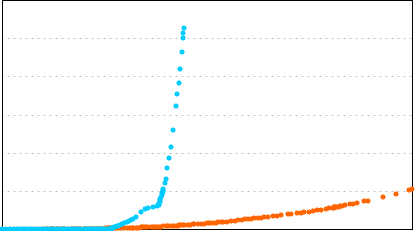
More soon.
Update: The long post is done…the above graph is (roughly) the growth of Blogger (in orange) to the growth of Twitter (in blue).
A map of online communities. Notable features include the Blogipeligo, the Bay of Trolls, the Sea of Memes, and the Viral Straits. (thx, kayhan)
- Pruning the list of RSS feeds I follow.
- Digging.
- Writing about hoes.
- Keeping deer out of the
s.
- Growing my traffic.
- Worrying about bees.
- (Com)posting links?
- Weeding out spam from comment threads.
- ^s.
- There’s never enough thyme.
- Wondering about the weather.
Might be a little slow today on the ol’ kottke.org. It’s raining, some dude died and a bunch of techy/copyrighty blogs are sorta trying not to dance on his grave, and I’m wishing a long walk off a short pier to a bunch of alpha male, loudmouth, know-it-all bloggers who are calling the kettle black to a degree way past insanity (or is that inanity?). Isn’t it time you all shipped off to the Grey Havens or something? Sometimes I really don’t like this blogos-whatever that we’ve all built for ourselves…don’t we deserve better? That and the internet appears to be completely empty today, devoid of any new information. Melodramatically yours,
Mike Monteiro mocks up a cover for Post & Permalink, my suggested fake blogging magazine from last night’s post about the should-be-fake Blogger & Podcaster.
I’m still recovering from the shock upon learning last week that Blogger & Podcaster magazine is in fact real. I thought it was a not-so-clever parody. I mean, look at that cover, it’s just so over the top! (If I were to start a fictional magazine about blogging, I’d call it Post & Permalink in homage to Field & Stream).
In addition to a just-launched redesign, outside.in took a look at their data for the past six months and came up with a list of the “bloggiest neightborhoods” in the US. “The results below are based on a number of variables: total number of posts, total number of local bloggers, number of comments and Technorati ranking for the bloggers.” Interestingly (but upon reflection, not surprisingly), most of the places listed are in the process of gentrifying. Disclosure: I am an advisor to outside.in.
The NY Times published an article this morning on the efforts to develop a code of conduct for online discourse. The code is a reaction to recent comments made about blogger Kathy Sierra. Three things bother me about the proposed rules.
We take responsibility for our own words and for the comments we allow on our blog.
I don’t want to take one bit of responsibility for someone else’s words. A person’s words are their own. By taking responsibility for them, you open yourself up to all sorts of problems, mostly legal in nature. Why should someone get sued for slander or libel because someone else posts something on your site? Of course, I also believe that Google isn’t responsible for people posting copyrighted videos to YouTube, that Napster wasn’t responsible for people trading copyrighted material via its service, and that ISPs aren’t responsible for what their customers publish to the web.
We do not allow anonymous comments.
There has to be a mechanism for anonymous comments, even if they need to be approved before being posted. As the EFF says, “anonymous communications have an important place in our political and social discourse”.
The missing piece in this discussion so far is: who’s going to police all this misconduct? Punishing the offenders and erasing the graffiti is the easy part…fostering “a culture that encourages both personal expression and constructive conversation” is much more difficult. Really fucking hard, in fact…it requires near-constant vigilance. If I opened up comments on everything on kottke.org, I could easily employ someone for 8-10 hours per week to keep things clean, facilitate constructive conversation, coaxing troublemakers into becoming productive members of the community, etc. Both MetaFilter and Flickr have dedicated staff to perform such duties…I imagine other community sites do as well. If you’ve been ignoring all of the uncivility on your site for the past 2 years, it’s going to be difficult to clean it up. The social patterns of your community’s participants, once set down, are difficult to modify in a significant way.
For now, my blogger code remains “B9 d+ t+ k++ s u= f++ i o x+ e++ l- c—”.
Pentagram’s Paula Scher illustrates the typical lifecycle of a blog discussion for the NY Times. More and more, I’m seeing threads skip immediately to steps 9 & 10: “Impugn the character of thesis author” and “Impugn character of anyone who even considered agreeing”.
The temptation these days for those of us with our heads buried online all day is to call any collection of short text pieces “blog-like”. I’m going to stay on-message here and refer to J. Robert Lennon’s Pieces for the Left Hand as being rather like a Diaryland diary written by someone who is particularly clever, smart, and funny. So maybe not so blog-like after all. (Burn!)
Anyway, Pieces is a collection of 100 or so 1-to-2 page stories, both fiction and non, about, well, nothing in particular, which is why I enjoyed them so much. Many of the stories are surreal, but not in the obvious David Lynch midgets-talking-backwards kind of way. They’re more subtle, a small-town kind of surreality. And for me, the perfect thing to read on the train or plane, literary snacks to have with your pretzels.
Shorpy, the 100-year-old photoblog, is pulling photos from just after the turn of the century and posting them. This one’s going right in the daily reads pile.
As I mentioned the other day, I recently joined Twitter. I’ve been poking around its nooks and crannies ever since. Here are some observations, presented in Twitter-sized chunks:
Playing with Twitter reminds me of blogging circa 2000. Back then, all weblogs were personal in nature and most people used them to communicate with their friends and family. If I wanted to know what my friends were up to back then, I read their blogs. Now I follow Twitter (and Flickr and Vox).
The reaction to Twitter mirrors the initial reaction to weblogs…the same tired “this is going to ruin the web” and “who cares what you ate for dinner” arguments.
Also like blogs, everyone has their own unique definition of what Twitter is (stripped down blogs, public IM, Dodgeball++, etc.), and to some extent, everyone is correct. Maybe that’s when you know how you’ve got a winner: when people use it like mad but can’t fully explain the appeal of it to others. See also: weblogs, Flickr.
For people with little time, Twitter functions like an extremely stripped-down version of MySpace. Instead of customized pages, animated badges, custom music, top 8 friends, and all that crap, Twitter is just-the-facts-ma’am: where are my friends and what are they up to?
Twitter’s like Flickr without the images.
When one thing (i.e. Twitter) is easier than something else (i.e. blogging) and offers almost the same benefits, people will use it.
Twitter brings back the “type words in one box and press submit” thing that made Blogger so popular back in the day. Compare with current blogging systems. To publish a post in MT, I’ve got to fiddle with 7-9 different text boxes and options. See immediately above.
Let’s not forget Dodgeball here, which was used extensively at SXSW in 2006. (In other words, all the Twittering at SXSW 2007 was not unprecedented. Chill.) It’s more focused on location and SMS though…by allowing updates in more ways and being more flexible about the type of message allowed, Twitter is attractive to a wider group of people.
If your friends are not on Twitter, I can’t imagine it would be that interesting.
Twitterholic tracks the top 100 Twitter users in terms of followers. I know, let’s not turn absolutely everything on the web into a popularity contest!! We already know Scoble is a big blowhard and has weak ties to lots of people…let’s move on, shall we?
I wonder what the average number of followers per person is? The folks with 5 zillion followers get all the attention, but as with blogging, those posting updates for their 20 friends form the bulk of the activity.
Lists of friends and followers are presented alphabetically. Does Anil attract more friends, on average, than Veen because he always shows up near the top of the listings?
I can see why Obvious dropped Odeo for Twitter. With podcasts, you’ve got all that data locked up in binary format (no easy cut-and-paste) and it takes you 20 listening minutes before you can react to it (by commenting, by linking, etc.). With blogs, the reaction time to a post is 1-2 minutes, with Flickr it’s 5 seconds, and Twitter is 2-3 seconds. The barrier to entry for reacting to and remixing podcasts is just so much higher.
Twitter is the first thing on the web that I’ve been excited about in ages. Like years. The last thing was probably Flickr. (Talk about burying the lede.) It’s just so damn simple but useful. Again, reminds me of weblogs in that way.
If you’re on a Mac and using Twitter, download Twitterific, a little app that sits on your desktop and displays updates from your friends. My only complaint: it doesn’t completely show updates, forcing you to the web to read the last 2-3 words of a longish message. Come on…it’s only 140 characters, show them all!
Twittermap displays recent Twitter messages on Google Maps. All you do is send Twitter a message with your location — like so…the “L:10003” is the important part — and Twittermap will pick it up.
Even more mesmerizing is Twittervision…a world tour of recent Twitter messages. Just sit back and watch the updates come in one at a time, displayed on a world map. (This is in beta and Twitter’s having some downtime issues right now, so the data may be less than fresh when you go.)
Twitter seems to work equally well for busy people and not-busy people. It allows folks with little time to keep up with what their friends are up to without having to email and IM with them all day. Those with a lot of time on their hands can spend a lot of time finding new people to follow, having back-and-forths with friends all day, and updating their status 40 times a day. Too many web apps fail because they only appeal to those with abundant free time.
I’m fascinated to see where Obvious takes this app once they get their scaling issues under control.
The default display of recent messages plus your own messages is genius. Makes it feel more like a conversation. The “with friends” display is great too…perfect for discovering other people to follow.
“Friends” still isn’t the right word.
The WTFCNN blog takes CNN to task for their increasingly non-news news headlines. I’d highlight quite a few more things…all the Britney and Anna Nicole headlines for a start.
Vogue is adding blogs to their site but editor Anna Wintour hates the word “blog” so much that she’s got her staff working on alternate language. Wintour’s a little late to the party…everyone I know has been hating that word since 1999. (via fashionologie)
Bruce Sterling: not many blogs will be around in 10 years. Listen to Sterling’s entire rant here. ps. Seven years ago on Bruce Sterling’s porch.
Wired’s cover feature for the March 2007 issue is Snack Culture. “Movies, TV, songs, games. Pop culture now comes packaged like cookies or chips, in bite-size bits for high-speed munching. It’s instant entertainment - and boy, is it tasty.” Even though kottke.org is a part of this culture, I still prefer a full meal.
Stay Connected